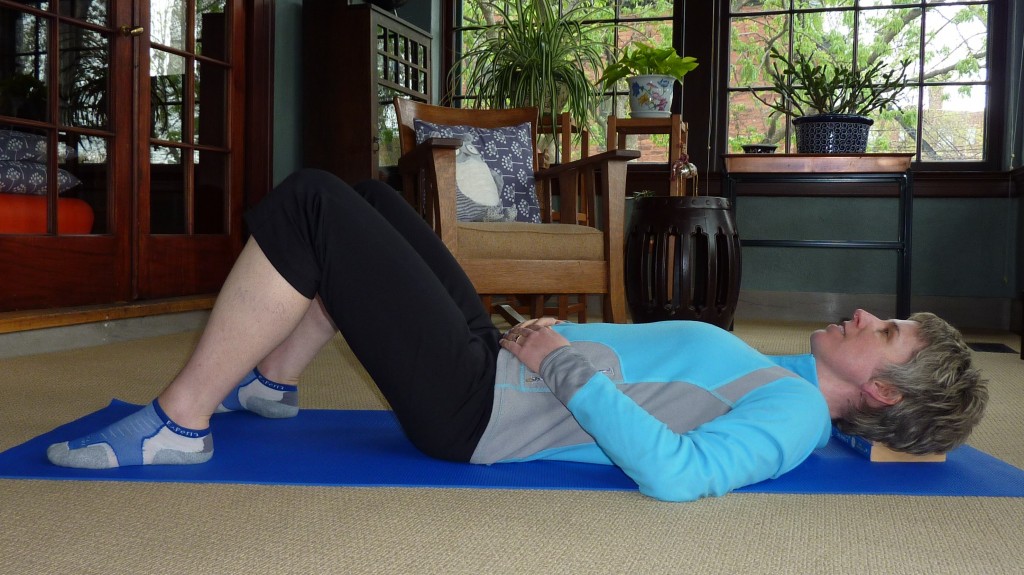One of the simplest ways to help yourself improve your posture, reduce excess tension, and manage the effects of stress is the Alexander Technique Constructive Rest practice.
Constructive Rest is a subtle combination of a supportive bodily position that encourages gentle release through the neck and back and consciously directed thought to help redistribute muscular tone throughout the body.
Don’t let the simplicity of the practice fool you. Over time if practiced on a daily basis it can be immensely helpful. My students who make Constructive Rest a daily practice from the start of their lessons with me tend to progress much faster than the ones who don’t.
Even if you’ve never worked with an Alexander teacher you can benefit from resting in this position on a daily basis.
This 15-minute interview with Alexander teacher, Amy Ward Brimmer is a great introduction to the position and practice.
The Basic Position
Lie down on your back on a firm padded surface such as a nice soft carpet or a yoga mat on the floor.
Bend your knees and stand your feet on the floor about hip-width apart. You want the legs to balance with minimum effort so the knees can point toward the ceiling—don’t pull the knees together and don’t allow them to flop apart.
An alternate position for the legs is to drape them over a large bolster or to support the lower legs on a low ottoman. If you do support your legs in this way, let go of them so that the knees fall away from each other. Don’t try to point the knees toward the ceiling.
Support the back of your head with some paperback books. Make sure to place the books underneath your head. The books should not be in contact with the back of your neck.
If you’ve too few books, your head will tend to tilt backwards (chin higher than forehead) and it’ll be difficult to encourage muscular release through the back and neck. If the pile is too high, your chin will press uncomfortably on your throat. The optimum height is somewhere between these two extremes. If the books are too hard you can place a folded washcloth on top of them.
Bend your elbows and rest your hands on the front of your body (see the picture of me below).
Non-Doing
Most importantly, this is a time to stop and not do anything for a few minutes. Allow the floor and the stack of books to gently support you under the back of your head, your back, your elbows, and the soles of your feet.
The goal of this practice is not to flatten yourself against the floor, nor is it to relax and go heavy. So, don’t try to push yourself against the floor. Instead, allow gravity to help you rest gently onto the ground.
This practice allows your muscles to release excess tension so your whole body can lengthen and widen and muscular tone is redistributed.
Keep your eyes open. You want to rest but remain conscious.
Giving Directions
Keep your eyes open and practice giving the following gentle invitations to yourself as you continue to allow the floor to support you. There is nothing to do, force, or make happen. Don’t work hard to concentrate on these invitations. Instead, think them gently and let them go. Come back to them from time to time throughout your rest.
I invite…
- the muscles of my whole neck to be free of tension
- my head to gently release out, away from my shoulders
- my spine to lengthen
- my back to widen as I breathe
- my shoulders to release out to the sides
- my legs to release away from my hip joints, so my knees point to the ceiling
- my feet to rest on the floor and
- my breath to flow in and out of my body in its own easy rhythm
Practicing these thoughts during your lying down is what makes this a procedure and not just a rest on the floor.
When you’re finished decide that you’re going to get up. Roll onto your side and find your way up to standing in the way that’s best for you.
Take some of the ease you found during your time on the floor into the rest of your day.
Frequently Asked Questions
How often should I do Constructive Rest and for how long?
Preferably every day for 15-20 min. You’ll benefit most from this practice if you do it consistently every day than if you do it once a week for an extended period of time.
When is the best time to do Constructive Rest?
Do it during the day. Don’t wait and have it be the last thing you check off your to do list before you go to bed at night. Also, don’t discount the usefulness of doing it in the morning when your body is fresh. You don’t need to wait until you are tired or your back hurts to rest.
Is it OK to lie down for longer than 20 minutes?
Yes. However, if you find you’d like to lie down for longer than 20 minutes, try doing two 20-minute sessions instead of one long 40-minute session. Do one in the morning and one in the late afternoon, for example.
Is it just as effective to do it once a week for a longer period of time?
No. It’s sort of like brushing your teeth. Every day for a few minutes will be much more effective over time than a marathon stretch once a week.
Why shouldn’t I do this on my bed or sofa?
A soft surface such as a bed or sofa that molds to your curves won’t encourage the same release through your back as a firmer surface.
How can I avoid just falling asleep or drifting into day-dreams?
Remember to keep your eyes open. You want to practice resting while remaining conscious. If you find your thoughts somewhere else, bring your mind back to paying attention to the surface you are lying on and practice your Directions (see above). If you find you’re consistently falling asleep you probably need more sleep generally. Take care of that need first by going to bed earlier.
Is Constructive Rest akin to relaxation exercises?
Not exactly. The aim is not to relax and go heavy. It’s about allowing the muscles to release and lengthen so that there’s a redistribution of muscle tone throughout the system.
I keep getting interrupted by the phone ringing. What should I do?
Make a decision that the time you spend in Constructive Rest is a time you free yourself from any demands, including answering the phone. Turn it off if you can’t ignore it.
Can I listen to music while I do this?
This is a time to tune in to your body and your mind, not check out. Often we use things such as listening to music to completely check out. There’s a time and place for this. Try just resting quietly.

